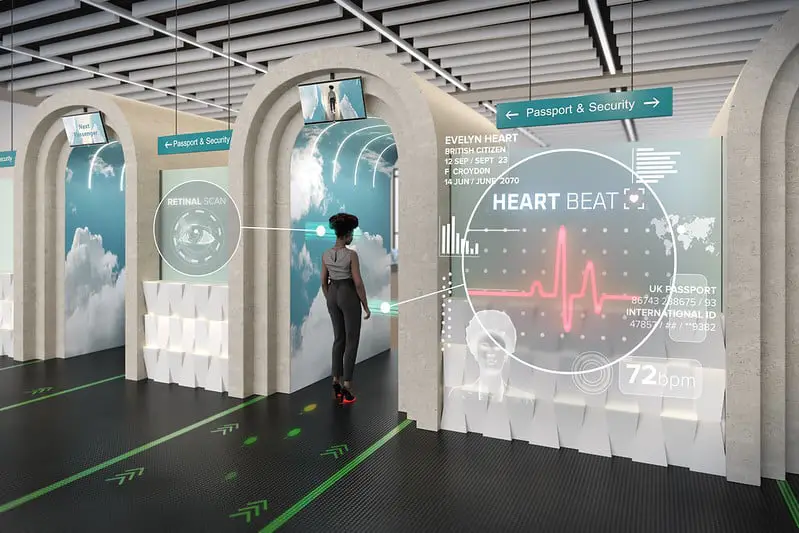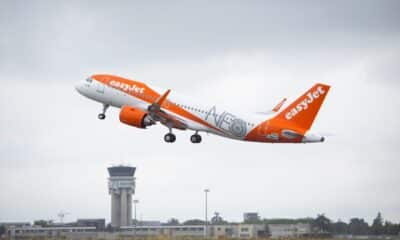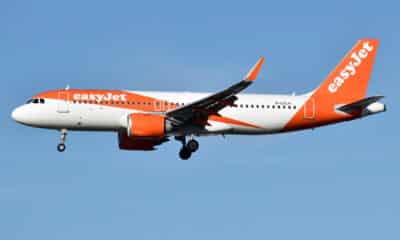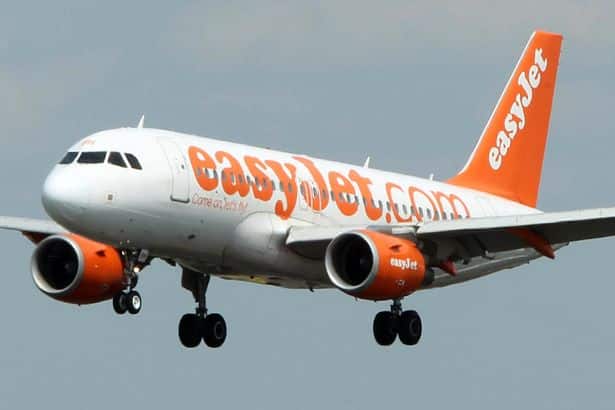Airlines
“Biomimetic Seats and Time Travel: easyJet’s Vision for Travel in 50 Years”
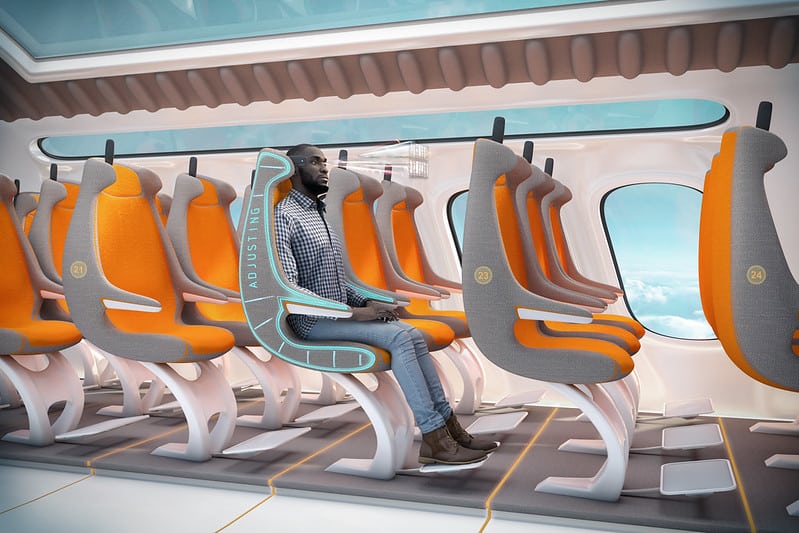
EasyJet 2070: The Future Travel Report highlights include:
The airport journey and air travel experience will be revolutionized by technological advances:
-
Heartbeat and biometric passports will replace the traditional passport, for passengers to breeze through their airport. Much like fingerprints and the retina, every person’s cardiac signature is unique. Passengers’ heartbeat signatures and biometric details will be logged on a global system in the same way fingerprint scanning technology works today.
U.S. airlines Super Bowl Sunday Ad Highlights Industry-wide Hiring(Opens in a new browser tab)
-
Ergonomic and biomimetic sensory plane seats will become the norm, with smart materials adapting to passengers’ body shape, height, weight, and temperature, providing the ultimate tailored comfort flying experience
-
Inflight entertainment will be beamed directly in front of passenger’s eyes, via optoelectronic devices, replacing the need for onboard screens or downloading movies before you fly
-
e-VTOL air taxis will do away with the airport car park shuttle – the journey to the airport will be quicker and more convenient than ever before with 85% of passengers arriving by e-VTOLs from their homes to the terminal.
As technology advances, it will see significant advances in the accommodation experience abroad:
-
3D printed hotel buffet food will allow holidaymakers to 3D print whatever they want to eat for breakfast, lunch and dinner, while reducing food waste.
-
Subterranean hotels built into the fabric of the earth that are super energy efficient and at one with the environment
-
All hotel rooms will be smart rooms with beds already pre-made to exactly desired firmness, ambient temperatures and favourite music playing based upon preferences you select in advance of booking the holiday
-
A holographic personal holiday concierge will accompany holidaymakers to provide up to date destination information and assistance throughout their stay
-
3D printed, recyclable holiday clothes on arrival at the hotel will remove the need for suitcases and fast holiday fashion as travellers can print the clothes required in their hotel rooms, tailored to their perfect fit and style, and recycle the materials for the next guest to enjoy.
-
Human powered hotels which harvest energy from its guests’ footsteps in order to generate power
Four of the expert predictions have been brought to life in incredibly detailed renders, showcasing how travel could look in 2070.
The impressive visuals depict travellers using their unique heartbeats to get through security at the airport, as well as a new way of flying as aircraft are fitted with adaptable, biomimetic seats, with entertainment beamed directly into their eyes. Other images show holidaymakers viewing a true-to-life Colossus of Rhodes wearing haptic suits, and selecting delicious 3D-printed food, personalised to their tastes. Three-quarters (75%) of Brits say that these technological advances would make them more likely to go on holiday in the future.
The survey of 2,000 British adults revealed that biometric heartbeat passports and time-travelling holiday experiences are the advancements in travel that the nation would most like to see happen by 2070.

Airlines
Air India’s last VVIP Boeing 747 now found a new home in USA

In a symbolic transition marking the end of a storied chapter in aviation history, Air India bid farewell to its last remaining Boeing 747-400 jumbo jetliners, once revered for ferrying dignitaries including prime ministers, presidents, and vice presidents.
The sale of these iconic aircraft to AerSale, a company based in the United States, signals the closure of a remarkable era for the airline.
The decision to part ways with the Boeing 747s was driven by practical considerations. Tata Group, the new custodian of airindia flights, deemed these majestic planes uneconomical to operate in today’s aviation landscape. As such, out of the four sold, two will be repurposed into freighters, while the remaining pair will be meticulously disassembled to harness their valuable parts.
The transaction, orchestrated by Mumbai-based Vman Aviation Services, underscores the strategic shift in Air India’s fleet management strategy under its new ownership. Tata Group’s decision to divest from the 747s reflects a commitment to optimizing operational efficiency and aligning with contemporary industry standards.
Skytech-AIC, a UK-based remarketing firm engaged by Tata Group, facilitated the sale of these iconic aircraft, marking the conclusion of their illustrious service with Air India. The airline’s last flight featuring the Boeing 747 took to the skies between Delhi and Mumbai in March 2021, encapsulating decades of distinguished service and indelible memories.
The allure of used aircraft parts continues to resonate across the aviation sector, offering operators a cost-effective alternative without compromising on quality or performance. The transfer of these aircraft to AerSale not only ensures their continued utility but also underscores the enduring legacy of Air India’s fleet.
Airlines
A software error caused grounding the entire airline fleet

On Wednesday, the U.S. Federal Aviation Administration (FAA) issued a ground stop advisory for all Alaska Airlines and subcarrier flights due to a software issue, disrupting travel plans for passengers.
The FAA directive, which prohibited the departure of Alaska Airlines mainline and subcarrier flights, was implemented as a precautionary measure following the detection of the software problem. The ground stop was initiated after Alaska Airlines encountered difficulties during a system upgrade related to the calculation of weight and balance for their flights.
As a result, the airline opted for a temporary suspension of all its operations to address the issue and ensure passenger safety. Alaska Airlines promptly issued a statement acknowledging the incident and expressing their commitment to resolving the matter swiftly. “This morning we experienced an issue while performing an upgrade to the system that calculates our weight and balance.
Out of an abundance of caution, we requested a ground stop for all Alaska and Horizon flights, which was instituted at approximately 7:30 a.m. PT,” the statement read. Passengers affected by the disruption voiced their concerns on social media platforms, prompting Alaska Airlines to reassure them of their efforts to minimize the inconvenience and expedite the resumption of flights.
Following approximately an hour-long interruption, the FAA lifted the ground stop order, allowing Alaska Airlines and its subcarriers to resume normal operations. However, it was clarified that SkyWest, which provides regional service for Alaska Airlines and other carriers, was exempt from the ground stop and continued its flights unaffected.
Aerospace
Which is bigger 777x or 787 aircraft ?

The 777X is a new series of the Boeing 777 family and is designed to be larger and more efficient than its predecessor. It features two variants: the 777-8 and the 777-9, being the larger of the two.
The Boeing 777X emerges as the larger sibling within the Boeing family, representing a significant leap forward in both size and efficiency. Comprising two variants, the 777-8 and the 777-9, the latter takes the crown as the larger of the two. With its expansive fuselage and impressive wingspan, the 777X is tailored for long-range journeys and boasts a substantial passenger capacity.
On the other hand, the Boeing 787, affectionately known as the Dreamliner, occupies a niche in the market as a smaller yet formidable aircraft designed for medium to long-range flights. Its distinguishing feature lies in its composite fuselage, a technological marvel that renders it lighter and more fuel-efficient compared to conventional aluminum counterparts. The Boeing 777X is larger than the Boeing 787 aircraft.
When it comes to passenger capacity, the 777-9 reigns supreme, typically accommodating a sizeable contingent of 400-425 passengers in its standard configuration. In contrast, the 787, with its more modest dimensions, typically carries between 240-290 passengers, depending on the variant and layout.
One of the remarkable innovations introduced with the 777X is its folding wingtips, a feature designed to address the logistical challenges of accommodating such a large aircraft in conventional airport gates. These folding wingtips enable the 777X to retract its wings, allowing it to fit into gates designed for smaller aircraft while still reaping the benefits of an extended wingspan during flight, thereby enhancing fuel efficiency and operational flexibility

